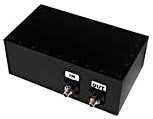|

Anatech Electronics, a manufacturer of RF and microwave
filters, has published its May 2016 newsletter. As always, it includes both company news and some tidbits about relevant
industry happenings. This month, Sam Benzacar discusses the increasing challenge that interference is to military systems,
how a new record has been set for spectral efficiency using a 256-QAM system, IoT being a prime target for hackers, and
more. Anatech's business is to make certain that system and circuit designers have capable filters available to assure successful
implementation.
Interference to Military Systems: An Increasing Challenge
 By Sam Benzacar By Sam Benzacar
Military and commercial wireless communications systems may have very different missions, but they have one big problem
in common: RF interference. Unfortunately, it's increasing every year despite comprehensive efforts by the Department of
Defense to find ways to mitigate it. For this we have to thank rapidly proliferating services over greater regions of the
spectrum, to which shortly be added communication systems designed to connect the so-called Internet of Things (IoT) devices
that are expected to number in the billions 10 years from now. And this is just from "friendly" sources, so when you combine
it with intentional jamming from adversaries the situation has become incredibly complex and extremely difficult to fix.
This is not a new problem, as interference was actually first encountered in the early part of the 20th century when
radios were added to cars and broadcast signals were decimated by interference from the car's electrical system. Surprisingly
the last time a thorough study of RF interference was conducted by US was by the Institute for Telecommunications Sciences
in the mid-1970s. Since that time, population of the spectrum by various services has expanded exponentially, causing a
situation in which commercial wireless systems, for example, are resorting to connecting blocks of spectrum in one band
with those of another band at a different frequency in order to get the bandwidth required to serve the massive increases
in traffic.
You might expect that military systems might get special treatment in terms of interference-free frequency allocations,
but just the opposite is true. DOD must attempt to justify every megahertz of spectrum it needs, although admittedly allocations
for government systems are extensive and often unused.
Although spread spectrum modulation and other technologies are being applied to the problem, as has been the case since
the early days of radio, the primary remedy for interference continues to be RF and microwave filters. Not only can they
solve problems before systems are deployed, they provide a ready remedy for interference that appears seemingly out of nowhere
in deployed systems.
Since 1990, Anatech Electronics has been solving interference problems in military systems at the design stage and in
the field with an excellent record of success. So if you have interference problems that seem to defy a solution, you should
contact us first. More than likely, we have an answer. You can reach us at (973) 772-4242, or by email at
sales@anatechelectronics.com.
What's News
Record Set for Spectral Efficiency
 Researchers and students working on
5G networks at the University of Bristol and Sweden's Lund University have set a new world record for spectral efficiency,
as reported by IEEE Spectrum. Using massive MIMO (multiple-input, multiple-output) antenna arrays with 128 elements, their
256-QAM system delivered 145.6 (bits/s)/Hz for 22 users on a shared 20-MHz channel at 3.51 GHz, a 22-times increase over
what's achievable with 4G networks. The previous record was 79.4 (bits/s)/Hz for 12 users followed by 71 (bits/s)/Hz set
by Facebook with 24 users using the company's 96-antenna ARIES array. The general consensus is that 5G will require an increase
in capacity of 1000 times to be effective. Researchers and students working on
5G networks at the University of Bristol and Sweden's Lund University have set a new world record for spectral efficiency,
as reported by IEEE Spectrum. Using massive MIMO (multiple-input, multiple-output) antenna arrays with 128 elements, their
256-QAM system delivered 145.6 (bits/s)/Hz for 22 users on a shared 20-MHz channel at 3.51 GHz, a 22-times increase over
what's achievable with 4G networks. The previous record was 79.4 (bits/s)/Hz for 12 users followed by 71 (bits/s)/Hz set
by Facebook with 24 users using the company's 96-antenna ARIES array. The general consensus is that 5G will require an increase
in capacity of 1000 times to be effective.
Google Seeking Pilots for Its Driverless Cars
 If you happen to live around Phoenix, you might
want to check out Google, which is hiring $20-per-hour "vehicle safety specialists" for its self-driving car testing in
the Chandler area, according to the Arizona Republic. You'll need a bachelor's degree, clean criminal and driving records,
and the ability to type 40 words per minute. The schedule is 6 to 8 hour workdays five days a week with 12 to 24 month contracts.
Testers will work in teams of two per vehicle, one behind the wheel to take over if necessary. The other tester will sit
in the passenger seat with a laptop documenting the testing and submitting reports. The "passenger" needs to focus constantly
on a range of software systems and give Google engineers concise written and oral feedback. If you happen to live around Phoenix, you might
want to check out Google, which is hiring $20-per-hour "vehicle safety specialists" for its self-driving car testing in
the Chandler area, according to the Arizona Republic. You'll need a bachelor's degree, clean criminal and driving records,
and the ability to type 40 words per minute. The schedule is 6 to 8 hour workdays five days a week with 12 to 24 month contracts.
Testers will work in teams of two per vehicle, one behind the wheel to take over if necessary. The other tester will sit
in the passenger seat with a laptop documenting the testing and submitting reports. The "passenger" needs to focus constantly
on a range of software systems and give Google engineers concise written and oral feedback.
Expert says IoT is Prime Target for Hackers
Cyber security veteran Josh Corman told attendees at the Building IoT conference in Cologne that without paying more
attention to security "chaos caused by the likes of Anonymous in traditional computing will seem like a picnic." Corman,
director of the Cyber Statecraft Initiative for the Atlantic Council, told the audience that as software and connectivity
are added to existing infrastructure, it's often being conducted without much attention to how these devices can be exploited
by hackers. He noted it will be up to individuals and developers to ensure security from the beginning, by designing systems
to minimize and recover from security failures in his organization, iamthecavalry.org. "For many years I believed if we
got the right message in front of the right people the adults would come and fix it," he said. However, "the cavalry isn't
coming...that's not going to happen." To illustrate the immense potential of this problem, Corman said that there is typically
one flaw for every 1000 lines of code. Microsoft Windows has about 10 million lines of code and a connected car might require
10 times that figure.
Mystery Rain On Radar Turns Out to Be "Chaff"
 The National Weather Service earlier this
month noticed that although it wasn't raining along the New Jersey shore, a large blob of blue and green colors (representing
precipitation) appeared mysteriously at 9:15 pm one day in May. The culprit turned out to be chaff, the small metallic fibers
used to confuse and deflect missiles from attacking aircraft. They were being used in a military training exercise off the
Atlantic coast, according to the NWS. This apparently occurs frequently, according to NWS. Its Long Island facility immediately
identified it by verifying the blob using dual-polarization radar. The chaff was detected in an area of the Atlantic Ocean
used as a military testing zone, running parallel to the Delmarva Peninsula. The National Weather Service earlier this
month noticed that although it wasn't raining along the New Jersey shore, a large blob of blue and green colors (representing
precipitation) appeared mysteriously at 9:15 pm one day in May. The culprit turned out to be chaff, the small metallic fibers
used to confuse and deflect missiles from attacking aircraft. They were being used in a military training exercise off the
Atlantic coast, according to the NWS. This apparently occurs frequently, according to NWS. Its Long Island facility immediately
identified it by verifying the blob using dual-polarization radar. The chaff was detected in an area of the Atlantic Ocean
used as a military testing zone, running parallel to the Delmarva Peninsula.
Check out Our Filter Products


LC Bandpass
Filters
Cavity Bandpass Filters
About Anatech Electronics
Anatech Electronics, Inc. (AEI) specializes in the design and manufacture of standard and custom RF and microwave filters
and other passive components and subsystems employed in commercial, industrial, and aerospace and applications. Products
are available from an operating frequency range of 10 kHz to 30 GHz and include cavity, ceramic, crystal, LC, and surface
acoustic wave (SAW), as well as power combiners/dividers, duplexers and diplexers, directional couplers, terminations, attenuators,
circulators, EMI filters, and lightning arrestors. The company's custom products and capabilities are available at
www.anatechelectronics.com.
Contact:
Anatech Electronics, Inc.
70 Outwater Lane
Garfield, NJ 07026
(973) 772-4242
sales@anatechelectronics.com
Posted April 12, 2016
|








 By Sam Benzacar
By Sam Benzacar Researchers and students working on
5G networks at the University of Bristol and Sweden's Lund University have set a new world record for spectral efficiency,
as reported by IEEE Spectrum. Using massive MIMO (multiple-input, multiple-output) antenna arrays with 128 elements, their
256-QAM system delivered 145.6 (bits/s)/Hz for 22 users on a shared 20-MHz channel at 3.51 GHz, a 22-times increase over
what's achievable with 4G networks. The previous record was 79.4 (bits/s)/Hz for 12 users followed by 71 (bits/s)/Hz set
by Facebook with 24 users using the company's 96-antenna ARIES array. The general consensus is that 5G will require an increase
in capacity of 1000 times to be effective.
Researchers and students working on
5G networks at the University of Bristol and Sweden's Lund University have set a new world record for spectral efficiency,
as reported by IEEE Spectrum. Using massive MIMO (multiple-input, multiple-output) antenna arrays with 128 elements, their
256-QAM system delivered 145.6 (bits/s)/Hz for 22 users on a shared 20-MHz channel at 3.51 GHz, a 22-times increase over
what's achievable with 4G networks. The previous record was 79.4 (bits/s)/Hz for 12 users followed by 71 (bits/s)/Hz set
by Facebook with 24 users using the company's 96-antenna ARIES array. The general consensus is that 5G will require an increase
in capacity of 1000 times to be effective.  If you happen to live around Phoenix, you might
want to check out Google, which is hiring $20-per-hour "vehicle safety specialists" for its self-driving car testing in
the Chandler area, according to the Arizona Republic. You'll need a bachelor's degree, clean criminal and driving records,
and the ability to type 40 words per minute. The schedule is 6 to 8 hour workdays five days a week with 12 to 24 month contracts.
Testers will work in teams of two per vehicle, one behind the wheel to take over if necessary. The other tester will sit
in the passenger seat with a laptop documenting the testing and submitting reports. The "passenger" needs to focus constantly
on a range of software systems and give Google engineers concise written and oral feedback.
If you happen to live around Phoenix, you might
want to check out Google, which is hiring $20-per-hour "vehicle safety specialists" for its self-driving car testing in
the Chandler area, according to the Arizona Republic. You'll need a bachelor's degree, clean criminal and driving records,
and the ability to type 40 words per minute. The schedule is 6 to 8 hour workdays five days a week with 12 to 24 month contracts.
Testers will work in teams of two per vehicle, one behind the wheel to take over if necessary. The other tester will sit
in the passenger seat with a laptop documenting the testing and submitting reports. The "passenger" needs to focus constantly
on a range of software systems and give Google engineers concise written and oral feedback.  The National Weather Service earlier this
month noticed that although it wasn't raining along the New Jersey shore, a large blob of blue and green colors (representing
precipitation) appeared mysteriously at 9:15 pm one day in May. The culprit turned out to be chaff, the small metallic fibers
used to confuse and deflect missiles from attacking aircraft. They were being used in a military training exercise off the
Atlantic coast, according to the NWS. This apparently occurs frequently, according to NWS. Its Long Island facility immediately
identified it by verifying the blob using dual-polarization radar. The chaff was detected in an area of the Atlantic Ocean
used as a military testing zone, running parallel to the Delmarva Peninsula.
The National Weather Service earlier this
month noticed that although it wasn't raining along the New Jersey shore, a large blob of blue and green colors (representing
precipitation) appeared mysteriously at 9:15 pm one day in May. The culprit turned out to be chaff, the small metallic fibers
used to confuse and deflect missiles from attacking aircraft. They were being used in a military training exercise off the
Atlantic coast, according to the NWS. This apparently occurs frequently, according to NWS. Its Long Island facility immediately
identified it by verifying the blob using dual-polarization radar. The chaff was detected in an area of the Atlantic Ocean
used as a military testing zone, running parallel to the Delmarva Peninsula.

